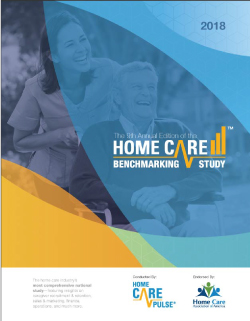What Can Data Do For You?
To celebrate the release of the 2018 Home Care Benchmarking Study from Home Care Pulse, we are happy to present a guest post from HCP’s Connor Kunz. Here, Connor shares some of the findings from the 2018 Benchmarking Study and breaks down how you can put this data to work for your agency.
 Here at Home Care Pulse, we’re big on data. Our mission is to help home care agencies decrease turnover, improve quality of care, and grow revenue.
Here at Home Care Pulse, we’re big on data. Our mission is to help home care agencies decrease turnover, improve quality of care, and grow revenue.
One way we do this is through the annual Home Care Benchmarking Study. With data gathered from more than 150,000 interviews with clients and caregivers and survey responses from over 700 home care agencies throughout North America, this year’s Benchmarking Study was the largest study yet.
The data gathered in it helps you measure your agency against industry benchmarks, identify trends over time, and understand how other agencies are operating. Here are some highlights from this year’s study that can help you to decrease turnover, improve quality of care, and grow revenue:
Decrease Turnover
A major section of the Benchmarking Study addresses caregiver turnover. Turnover rates in the industry have trended upwards for years; this year, industry caregiver turnover rates reached a new high of 66.7%. Thankfully, the data isn’t all bad news; though this data point represents an ever-present challenge for home care agencies, the data from the study also reveal solutions. For instance, higher wages are correlated to lower turnover. So how do you find the sweet spot between reducing turnover and keeping reasonable wage expenses?
According to the Study, agencies paying caregiver wages in the top 75th percentile have a median turnover rate of 59.5%, whereas those paying in the lower 25th percentile have a median turnover rate of 70.6%. You don’t need to be the highest-paying agency out there, but you want to get close to that 75th percentile if you want to see a good impact on your caregiver turnover. This varies by region and depends on other factors but typically means a wage increase of about a dollar; for instance, in the Northeast, agencies paying in the 25th percentile pay their caregivers $10-11 an hour, while agencies in the 75th percentile pay $11.50-13 dollars an hour.
While increased wages may seem like a high price to pay for an 11% reduction in turnover, it’s important to consider the benefits that decreased turnover could bring to many different aspects of your business: more experienced caregivers, less time spent by management on recruiting, and less time spent training new caregivers, among other benefits. Reducing turnover by increasing pay may impact your business positively in ways you might not even guess.
Improve Quality of Care
Sometimes, data provides solutions that are deceptively simple. While increasing quality of care is already a focus of most, if not all, home agencies, the Benchmarking Study provides insights into solutions you may not have considered.
For example, the area of client experience where agencies score the lowest across the industry is in communication from the provider. For those with access to this information, this is good news. When it comes to ways you can make clients happier, communication is low-hanging fruit.
Maintaining stronger communication with clients is a relatively easy way for agencies to significantly improve client satisfaction in a short amount of time. This may be as simple as scheduling more frequent check-up calls from office staff, management, or caregiver supervisors to follow up on the services provided and check if the client’s needs are being met.
In addition, communication from the provider is also highly correlated with clients’ willingness to refer, making improved communication an important way to increase the number of referrals you receive through current clients.
Grow Revenue
Learning to use improved communication to generate increased referrals is a perfect example of the Benchmarking Study in action. Ultimately, the data provided by the Benchmarking Study should give you the tools needed to help you grow your revenue.
Efforts to increase revenue are typically divided into two categories: consumer marketing and referral sources. The above example of increasing client referrals through improved communication is critical because referrals from past and current clients was the number one source of new referrals in 2017.
Despite the prevalence of this method, many home care owners still undervalue the importance of seeking client referrals. A metric discussed in the Benchmarking Study called the Net Promoter Score® uses your agency’s client satisfaction scores to calculate and track your clients’ likeliness to refer others to you. The overall NPS® score for the home care industry in 2017 was 5.6. Calculating your Net Promoter Score and comparing it to the industry NPS can help you see how effective you are at generating referrals from clients versus other agencies in the industry and help you identify whether you are underutilizing your clients as a channel for new referrals.
A Wealth of Insights
Data can help agencies in a number of ways, not the least of which is providing key performance indicators in care homes can allow them to assess processes, make positive changes, and grow. While we hope the examples discussed above will be of value to your agency, this is only a snapshot of the wealth of insights provided by the Home Care Benchmarking Study. Other topics addressed in the study include recruitment and retention, finance, operations, client experience, sales and marketing, and more. To get the full benefit of the 2018 Home Care Benchmarking Study, order your copy now and use the promo code ROSEMARK to get $50 off. It’s time to find out what better data can do for you.
